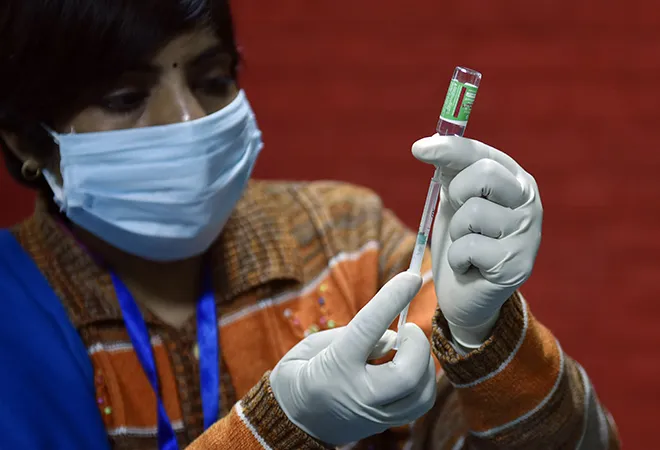
While vaccines usually require years of testing and research, the COVID-19 pandemic saw an unprecedented effort by medical researchers globally to produce a safe and effective vaccine. In December 2020, after a year full of health crises and economic downturns, the COVID-19 vaccine was available to the public at a record pace. One of the biggest and fasted vaccination campaigns in human history is now underway.
As of now, the COVID vaccine campaign has observed more than 131 million doses being administered globally, across 73 countries. The average daily rate of doses administered is 4.68 million. Estimates by the Bloomberg Covid Vaccine tracker suggest that at the current rate, it will take approximately 6.7 years to cover 75 percent of the global population with a two-dose vaccine. At this pace, it will take years to reach global immunity from the virus; however, the steady rise in inoculations, coupled with consistent research into new vaccines and protective measures, promises a positive future.
Currently, there are 67 vaccines under clinical trials and at least 89 are in the pre-clinical investigation stages. Twenty vaccine candidates are in the third phase of large-scale vaccine efficacy trials, while four have been approved for use, namely, Pfizer-BioNTech, Moderna (both Pfizer and Moderna were fully approved in Bahrain, Saudi Arabia, Switzerland, and but are in emergency use in the US, EU, and other countries), Sinopharm (approved in China, UAE, and Bahrain) and Sinovac (conditional approval in China) vaccines. On the other hand, four vaccines were abandoned after trial.
Figure 1: Global Covid Vaccine Trend
 Author’s own, data source: Our World in Data
Author’s own, data source: Our World in Data
Presently, the vaccine drive is being led by the United States, with more than 42 million doses administered, as of February 7. The USA is followed by China and the UK with 31 million and 12 million doses administered, respectively. While the US and China lead in absolute doses administered, Israel’s inoculation surpasses that of other countries with 61 doses administered for every 100 people. USA and China seem to be lagging behind with 12.7 and 2.2 doses per 100 population, attributed to the larger population base.
Figure 2: Country wise Covid vaccine doses administered
 Author’s own, Data source: Bloomberg Vaccine tracker
Author’s own, Data source: Bloomberg Vaccine tracker
India’s COVID Vaccine Update
The last two months have observed a steady decline in COVID-19 cases in India. While total confirmed cases in India have surpassed 10.8 million, India’s recovery rate has been consistent at 97 percent (10.5 million recoveries). COVID-19 deaths in India have also observed a decline, with only 86 reported deaths in the past 24 hours, taking the total to 155,118.
India started its COVID vaccination journey on January 16 2020 with two major vaccines, namely the SII-Oxford-AstraZeneca Covishield vaccine and the Bharat Biotech-ICMR Covaxin vaccine. Even though the Indian government has approved Bharat Biotech’s Covaxin for emergency use, the vaccine is still in its phase-3 of clinical trials, which has led to many front line and health care workers refusing the vaccine. The hurried approval of the vaccine has caused hesitancy towards its use, leading to a fallout in India’s vaccine rollout with a little more than half the targeted population coming forward for the vaccination.
Nevertheless, India has successfully administered more than 5.8 million doses in less than one month, making India the fourth highest country in terms of total vaccine doses administered, behind the US, China and the UK. On an average, India has been able to administer 267,675 doses on a daily basis. The below figure shows India’s consistent daily vaccine coverage, with a steep fall seen on the weekends due to closure of most government facilities.
Figure 3: Covid Vaccine Trends in India
 Author’s own, Data source: Ministry of Health and Family Welfare, Government of India
Author’s own, Data source: Ministry of Health and Family Welfare, Government of India
Currently, Uttar Pradesh leads in the country with 673,542 doses administered, while Union Territory Lakshadweep lags with 839 doses administered. However, when closely observing the vaccine statistics, Lakshadweep leads with 11.4 doses administered per 100 people. When it comes to the bigger states, Kerala is amongst the highest with ~8 doses for every 1000 people. On an overall level, India has administered 4.2 doses for every 1000 people.
Figure 4: Covid Vaccine Trends in Indian States
 Author’s Own, Data source: Observer Research Foundation Vaccine Tracker
Author’s Own, Data source: Observer Research Foundation Vaccine Tracker
With the immunisation drive underway, India is also working towards the development of seven COVID-19 vaccines, in an effort to reach each citizen of the country. At the moment, only health care and front-line workers are being vaccinated and closely monitored, in order to ensure the vaccines are safe for use in the open market. Union Health Minister Harsh Vardhan stated that India will be beginning the next phase of vaccinating people aged 50 years and above in March.
Table 1: Ongoing Vaccine Trials in India
| Phase |
Vaccine |
No. of Doses |
Start date |
Estimated Primary completion date |
| Phase III |
Bharat Covaxin |
2 |
25/11/2020 |
30/06/2021 |
| Phase II/III |
Gamaleya Gam-COVID-Vac/Sputnik V |
2 |
30/11/2020 |
30/08/2021 |
| Phase II/III |
Oxford ChAdOx1-S |
2 |
24/08/2020 |
24/03/2021 |
| Phase I/II |
Zydus Cadila ZyCoV-D |
3 |
13/07/2020 |
13/07/2021 |
| Phase I/II |
Bharat Covaxin |
2 |
13/07/2020 |
30/06/2021 |
| Phase I/II |
Biological E Ltd BECOV |
2 or 3 |
16/11/2020 |
16/01/2022 |
| Phase I/II |
Bharat Covaxin |
2 |
8/9/2020 |
8/5/2021 |
Source: Covid-19 Vaccine Tracker
An equitable way forward
Since the inception of the global vaccination campaign, a somewhat worrying trend has been observed in terms of unequal access to the vaccine. Even with emergency approvals and many countries racing to vaccinate their at-risk populations, only 73 countries have begun any kind of vaccination drives with seven vaccines available for public use.
Efforts to make a vaccine available to the global community are ongoing. However, with richer countries acquiring vaccine contracts at a high rate, it has been suggested that some countries may have to wait until 2022 to receive the vaccine. For instance, Canada with a meagre population of 38 million, has secured enough vaccine contracts to vaccinate 330 percent of its population. On the other hand, most African countries lag behind with ~5-6 percent of their population covered by the current vaccine contracts. The unequitable access along with the lack of logistical efficiency in vaccine delivery seem to the be biggest roadblocks as countries move forward.
After almost two months of the ongoing vaccination campaign, mostly high-income countries have been able to secure vaccine contracts and initiate the vaccination drives for their population. Some upper middle-income countries have also started the distribution of vaccine doses. In contrast, lower middle income and low-income countries have hardly even started vaccinating their vast populations. Figure 5 shows the lack of equity in vaccine distribution globally, wherein no low-income country has begun its vaccination drive. With the EU imposing COVID-19 vaccine export restrictions, the situation has been called a ‘worrying trend’ by the WHO.
Figure 5: Covid Vaccine Inequitable coverage
 Source: PandemIC Vaccine Equity Tracker
Source: PandemIC Vaccine Equity Tracker
India: the pharmacy of the world #VaccineMaitri
Amid worldwide controversy sparked by the vaccine diplomacy efforts, India has presented and prepared itself to aid the global pandemic recovery efforts. As per Union Home Minister Amit Shah, India is set to supply 70 percent of the world’s COVID-19 vaccine needs.
Since January, India has gifted over 55 lakh doses of vaccines to its neighbouring and other countries including Bhutan, the Maldives, Nepal, Bangladesh, Myanmar, Mauritius, the Seychelles, Sri Lanka and Bahrain. Over the course of the next few days, India will also be aiding the vaccination drives in Oman, Nicaragua, the Caribbean Community countries and the Pacific Island States.
India’s two key vaccines (SII-Oxford AstraZeneca and Bharat Biotech) will be exported to 14 countries. Commercial exports have already taken place with Brazil, Morocco, and Bangladesh, and discussions are proceeding with Saudi Arabia, South Africa, Canada, Mongolia and other countries. India will also be supplying a further 10 million doses to Africa and 1 million doses to UN health workers under GAVI's Covax facility.
As the world works its way towards a COVID-free future, a global treatment of the pandemic will be imperative. Policies that promote ‘shutting down and looking inwards’ must need to be replaced by a coordinated and integrated approach.
The views expressed above belong to the author(s). ORF research and analyses now available on Telegram! Click here to access our curated content — blogs, longforms and interviews.




 Author’s own, data source:
Author’s own, data source:  Author’s own, Data source:
Author’s own, Data source:  Author’s own, Data source:
Author’s own, Data source:  Author’s Own, Data source:
Author’s Own, Data source:  Source:
Source:  PREV
PREV


